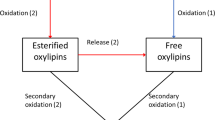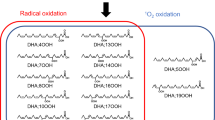Abstract
The oxidation of free DHA, DHA mixed with PC, and DHA incorporated into PC, PE, or TG was evaluated to determine which lipid provided DHA with the best protection against oxidation. DHA was either situated at the sn-1 position, sn-2 position, or both positions of the phospholipid, whereas the TG contained DHA at all positions. All lipids were incubated as bulk lipids, in chloroform, or as an emulsion in contact with air at 25–30°C for 28 d. Since DHA, which is highly sensitive to oxidation, has a great impact on our health and is desired as a food additive, the stability of this FA is of great importance. This study was mainly focused on the primary oxidation products, which were monitored as eight monohydroperoxy-DHA isomer groups, the total amount of polyhydroperoxides, and the PV. However, a measure of secondary oxidation products, the carbonyl value, was also monitored. We found that DHA was most protected against hydroperoxide formation when it was incorporated at one position of either PC or PE. In these lipids, hydroperoxide formation at carbon atoms 4, 7, 8, and 11 was completely prevented. DHA mixed with PC was also protected, although to a lesser extent, and all hydroperoxide isomers were detected. In contrast, PC and TG containing DHA at all positions should be avoided, since they were highly oxidized.
Similar content being viewed by others
Abbreviations
- AA:
-
arachidonic acid
- CV:
-
carbonyl value
- DMAP:
-
4-dimethylaminopyridine
- EDCI:
-
I-(3-dimethylaminopropyl)-3-ethylcarbodi-imide hydrochloride
- LPC:
-
lysophosphatidylcholine
- PLD:
-
phospholipase D
References
Birch, E.E., and O'Connor, A.R. (2001) Preterm Birth and Visual Development, Semin. Neonatol. 6, 487–497.
Horrocks, L.A., and Yeo, Y.K. (1999) Health Benefits of Docosahexaenoic Acid (DHA), Pharmacol. Res. 40, 211–225.
Lim, G.P., Calon, F., Morihara, T., Yang, F., Teter, B., Ubeda, O., Salem, N., Jr., Frautschy, S.A., and Cole, G.M. (2005) A Diet Enriched with the Omega-3 Fatty Acid Docosahexaenoic Acid Reduces Amyloid Burden in an Aged Alzheimer Mouse Model, J. Neurosci. 25, 3032–3040.
Horrobin, D.F. (1998) The Membrane Phospholipid Hypothesis as a Biochemical Basis for the Neurodevelopmental Concept of Schizophrenia, Schizophr. Res. 30, 193–208.
Stordy, B.J. (2000) Dark Adaptation, Motor Skills, Docosahexaenoic Acid, and Dyslexia, Am. J. Clin. Nutr. 71, 323S-326S.
Richardson, A.J., and Puri, B.K. (2000) The Potential Role of Fatty Acids in Attention-Deficit/Hyperactivity Disorder, Prostaglandins Leukot. Essent. Fatty Acids 63, 79–87.
Larsson, S.C., Kumlin, M., Ingelman-Sundberg, M., and Wolk, A. (2004) Dietary Long-Chain n-3 Fatty Acids for the Prevention of Cancer. A Review of Potential Mechanisms, Am. J. Clin. Nutr. 79, 935–945.
Holub, D.J., and Holub, B.J. (2004) Omega-3 Fatty Acids from Fish Oils and Cardiovascular Disease, Mol. Cell. Biochem. 263, 217–225.
Frankel, E. (1998) Lipid Oxidation. The Oily Press, Dundee, Scotland.
Kamal-Eldin, A., and Yanishlieva, N.V. (2002) n-3 Fatty Acids for Human Nutrition: Stability Considerations, Eur. J. Lipid Sci. Technol. 104, 825–836.
Yanishlieva, N.V., and Marinova, E.M. (2001) Stabilisation of Edible Oils with Natural Antioxidants, Eur. J. Lipid. Sci. Technol. 103, 752–767.
Song, J.H., Inoue, Y., and Miyazawa, T. (1997) Oxidative Stability of Docosahexaenoic Acid-Containing Oils in the Form of Phospholipids, Triacylglycerols, and Ethyl Esters, Biosci. Biotechnol. Biochem. 61, 2085–2088.
Sarney, D.B., Fregapane, G., and Vulfson, E.N. (1994) Lipase-Catalyzed Synthesis of Lysophospholipids in a Continuous Bioreactor, J. Am. Oil Chem. Soc. 71, 93–96.
Lyberg, A.-M., Adlercreutz, D., and Adlercreutz, P. (2005) Enzymatic and Chemical Synthesis of Phosphatidylcholine Regioisomers Containing Eicosapentaenoic Acid or Docosahexaenoic Acid, Eur J Lipid Sci Tech. 107, 279–290.
D'Arrigo, P., de Ferra, L., Piergianni, V., Selva, A., Servi, S., and Strini, A. (1996) Preparative Transformation of Natural Phospholipids Catalyzed by Phospholipase D from Streptomyces, J. Chem. Soc., Perkin Trans. 12651–2656.
Adlercreutz, D., Budde, H., and Wehtje, E. (2001) Synthesis of Phosphatidylcholine with Defined Fatty Acid in the sn-1 Position by Lipase-Catalyzed Esterification and Transesterification Reaction, Biotechnol. Bioeng. 78, 403–411.
Huang, S.-W., Hopia, A., Schwarz, K., Frankel, E.N., and German, J.B. (1996) Antioxidant Activity of α-Tocopherol and Trolox in Different Lipid Substrates: Bulk Oils vs. Oil-in-Water Emulsions, J. Agric. Food Chem. 44, 444–452.
Asakawa, T., and Matsushita, S. (1980) A Colorimetric Microde-termination of Peroxide Values Utilizing Aluminum Chloride as the Catalyst, Lipids 15, 965–967.
Jessup, W., Dean, R.T., and Gebicki, J.M. (1994) Iodometric Determination of Hydroperoxides in Lipids and Proteins, Methods Enzymol. 233, 289–303.
Endo, Y., Li, C.M., Tagiri-Endo, M., and Fujimoto, K. (2001) A Modified Method for the Estimation of Total Carbonyl Compounds in Heated and Frying Oils Using 2-Propanol as a Solvent, J. Am. Oil Chem. Soc. 78, 1021–1024.
King, M.F., Boyd, L.C., and Sheldon, B.W. (1992) Antioxidant Properties of Individual Phospholipids in a Salmon Oil Model System, J. Am. Oil Chem. Soc. 69, 545–551.
Araseki, M., Yamamoto, K., and Miyashita, K. (2002) Oxidative Stability of Polyunsaturated Fatty Acid in Phosphatidylcholine Liposomes, Biosci. Biotechnol. Biochem. 66, 2573–2577.
Endo, Y., Hoshizaki, S., and Fujimoto, K. (1997) Oxidation of Synthetic Triacylglycerols Containing Eicosapentaenoic and Docosahexaenoic Acids: Effect of Oxidation System and Triacylglycerol Structure, J. Am. Oil Chem. Soc. 74, 1041–1045.
Author information
Authors and Affiliations
Corresponding author
About this article
Cite this article
Lyberg, AM., Fasoli, E. & Adlercreutz, P. Monitoring the oxidation of docosahexaenoic acid in lipids. Lipids 40, 969–979 (2005). https://doi.org/10.1007/s11745-005-1458-1
Received:
Accepted:
Issue Date:
DOI: https://doi.org/10.1007/s11745-005-1458-1




